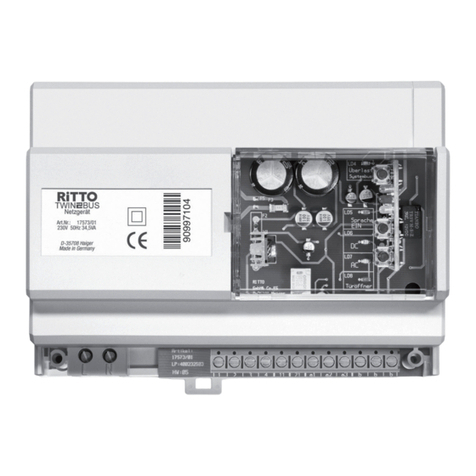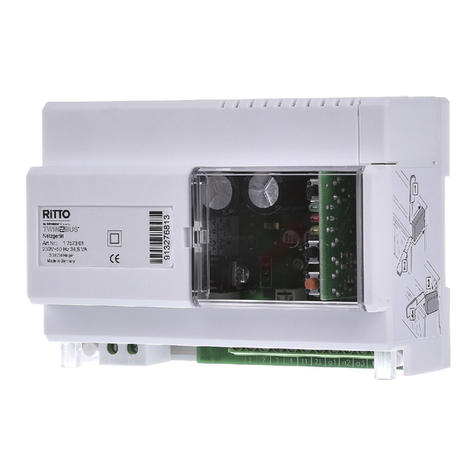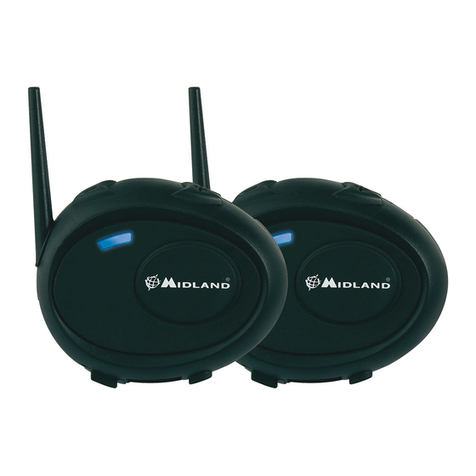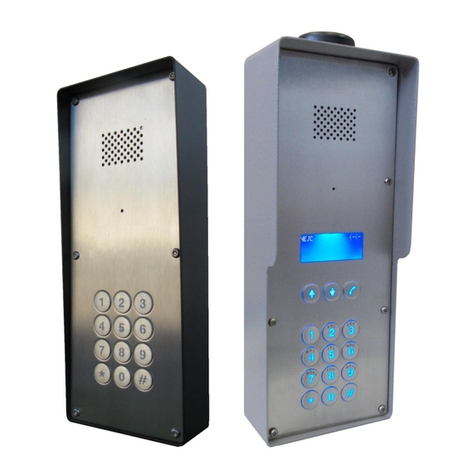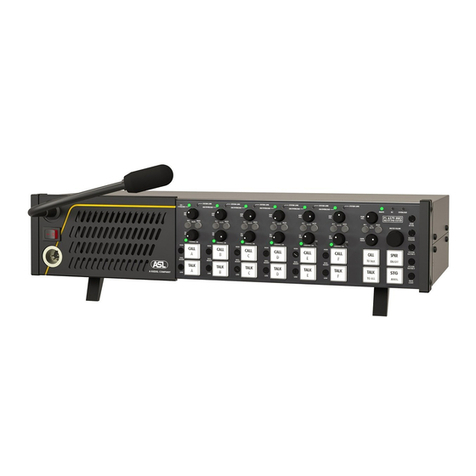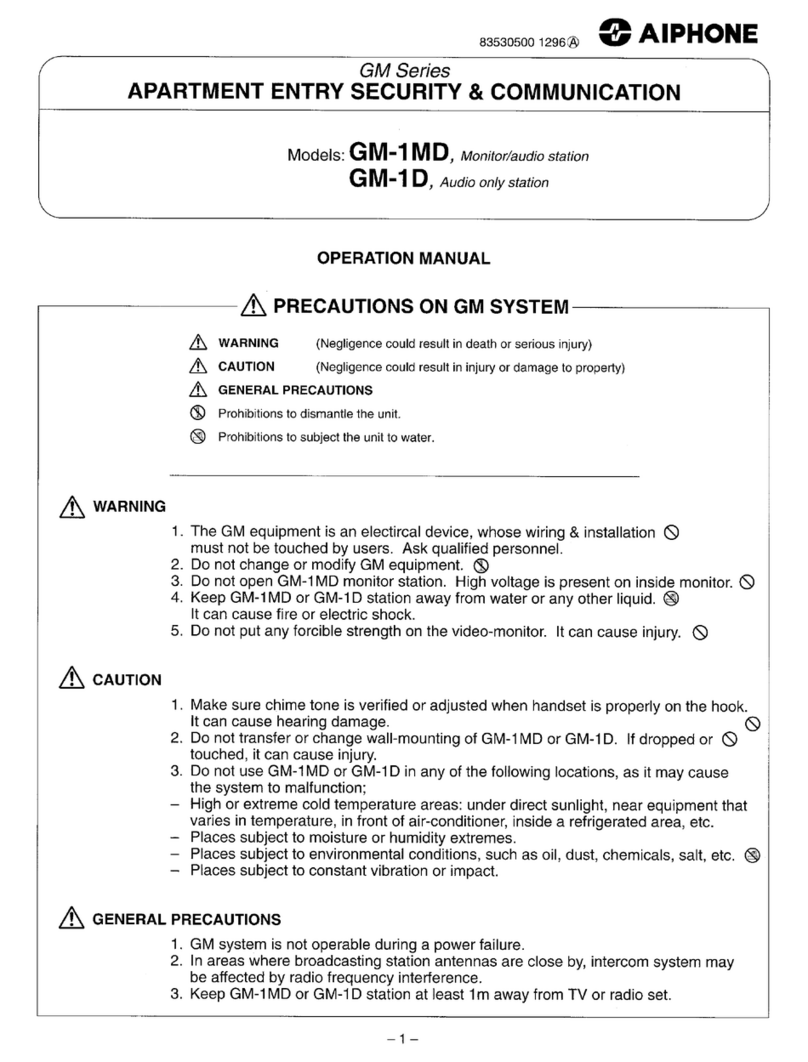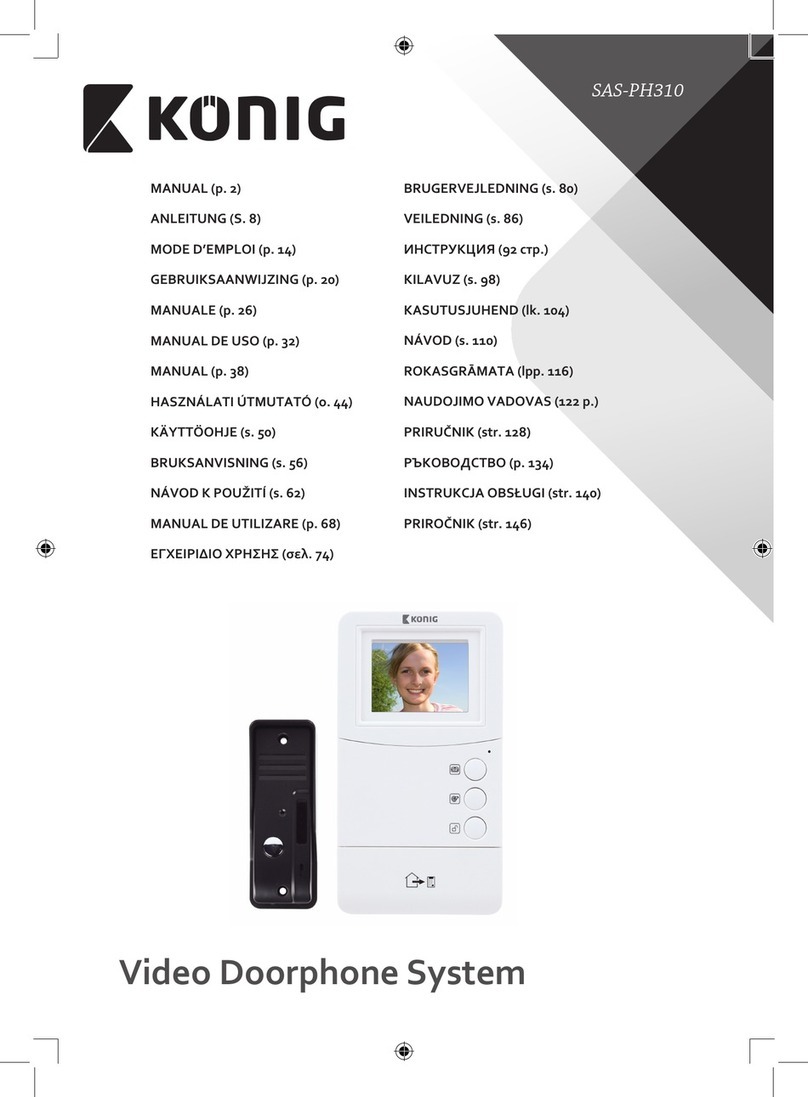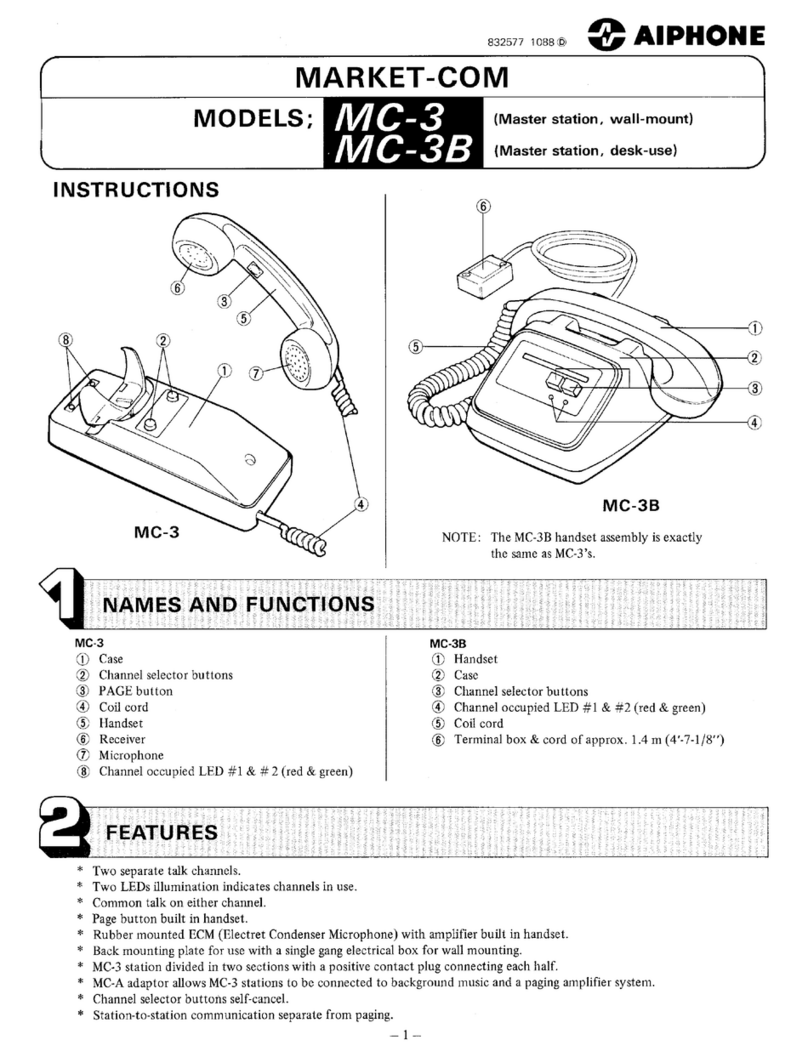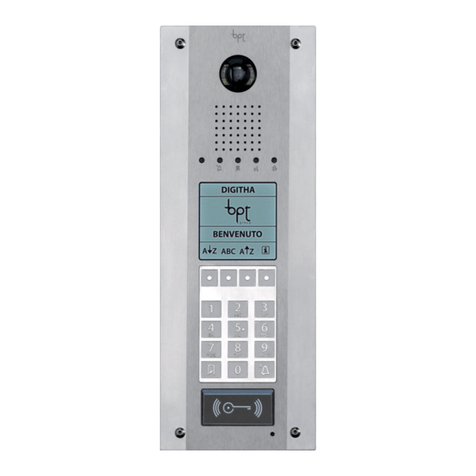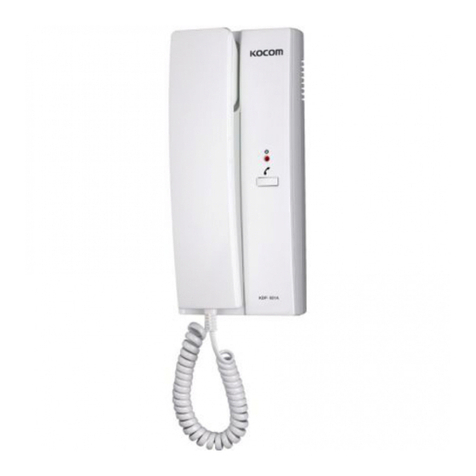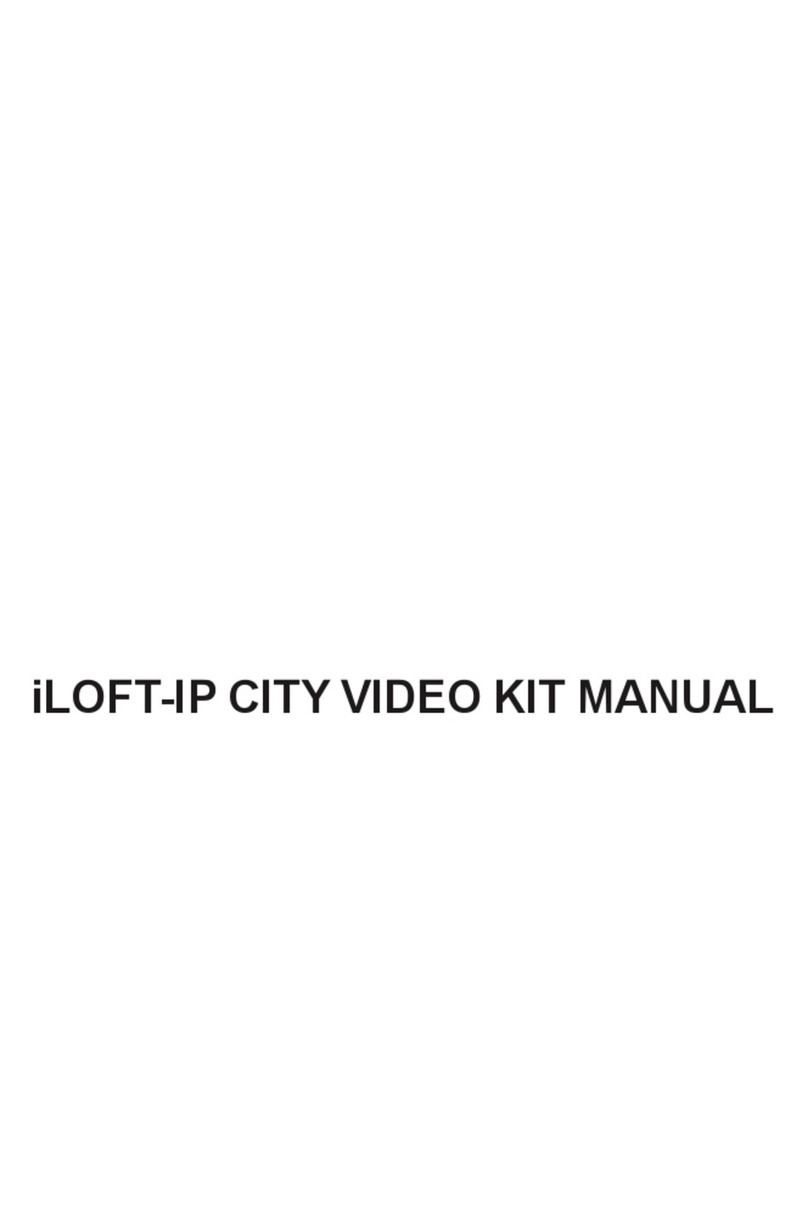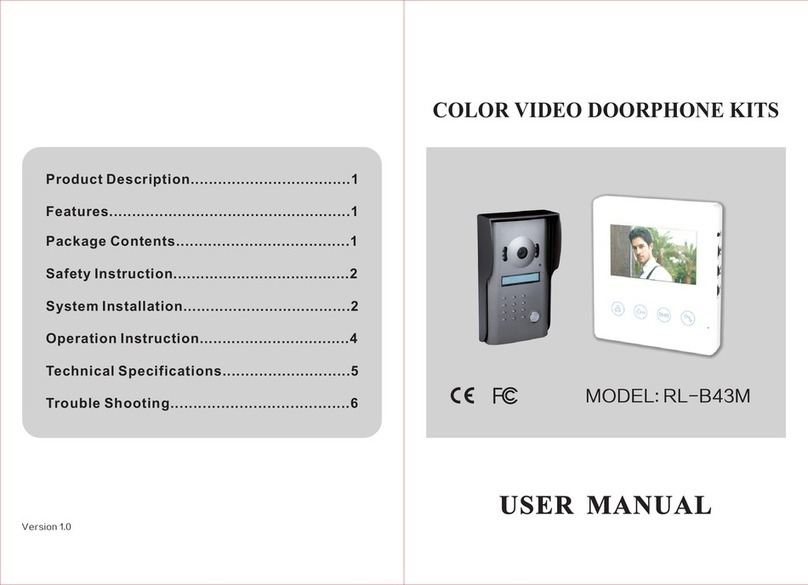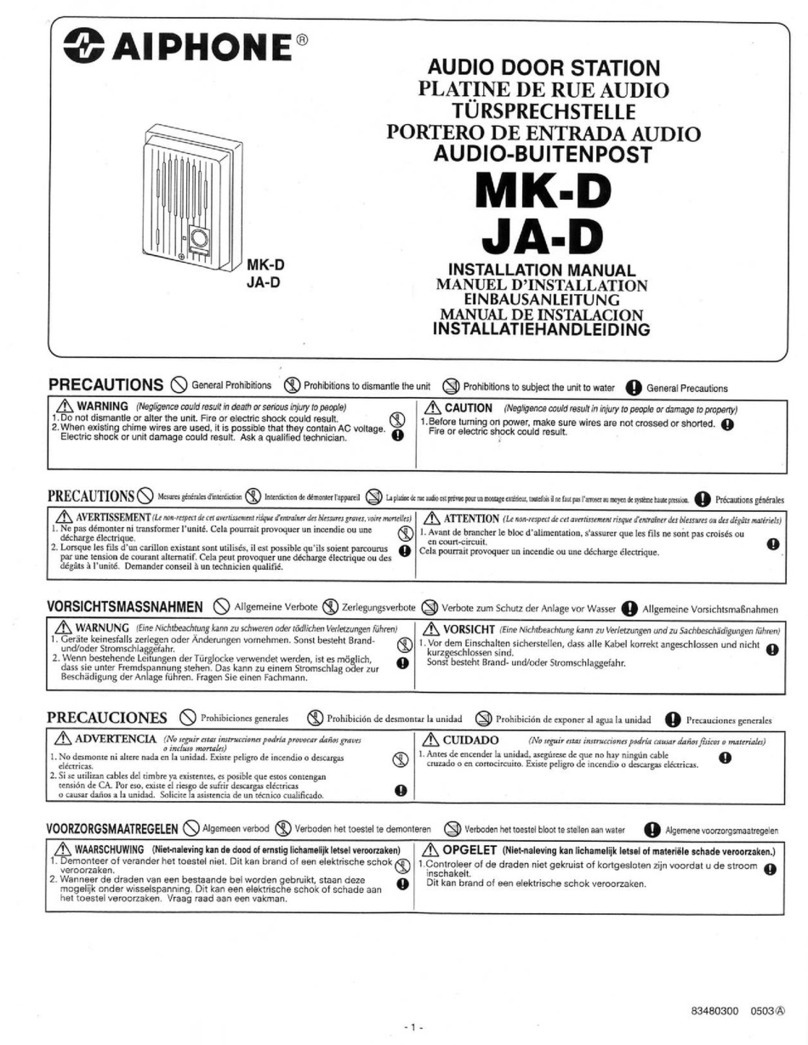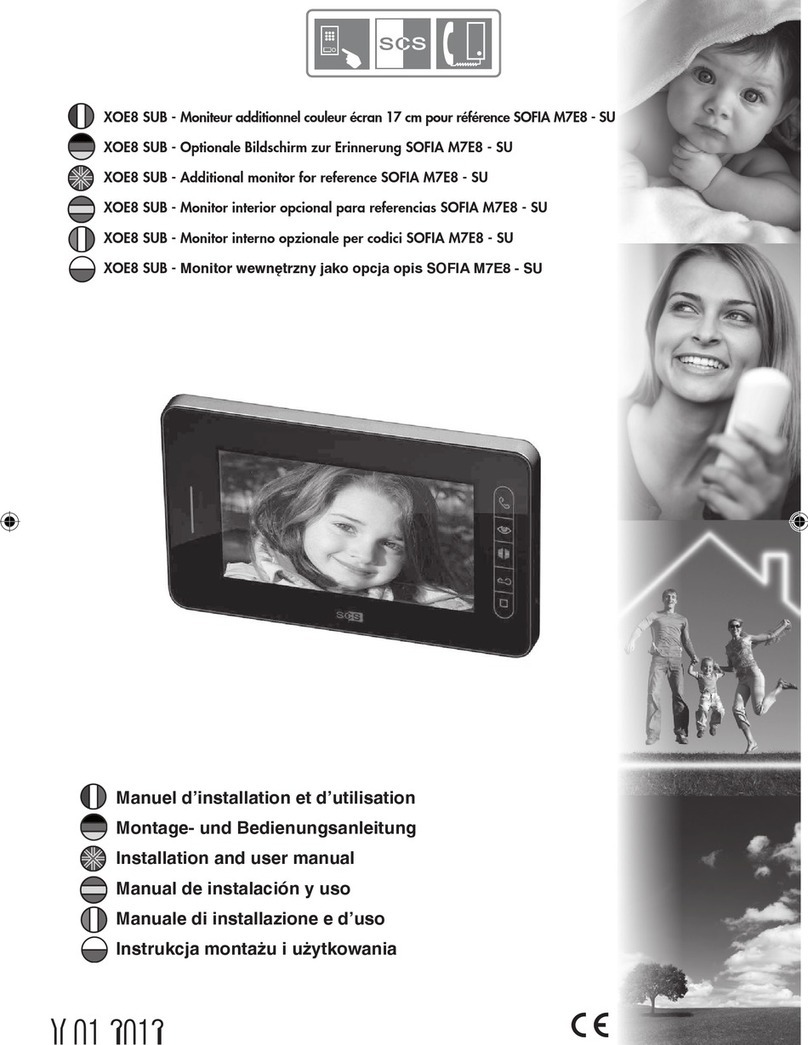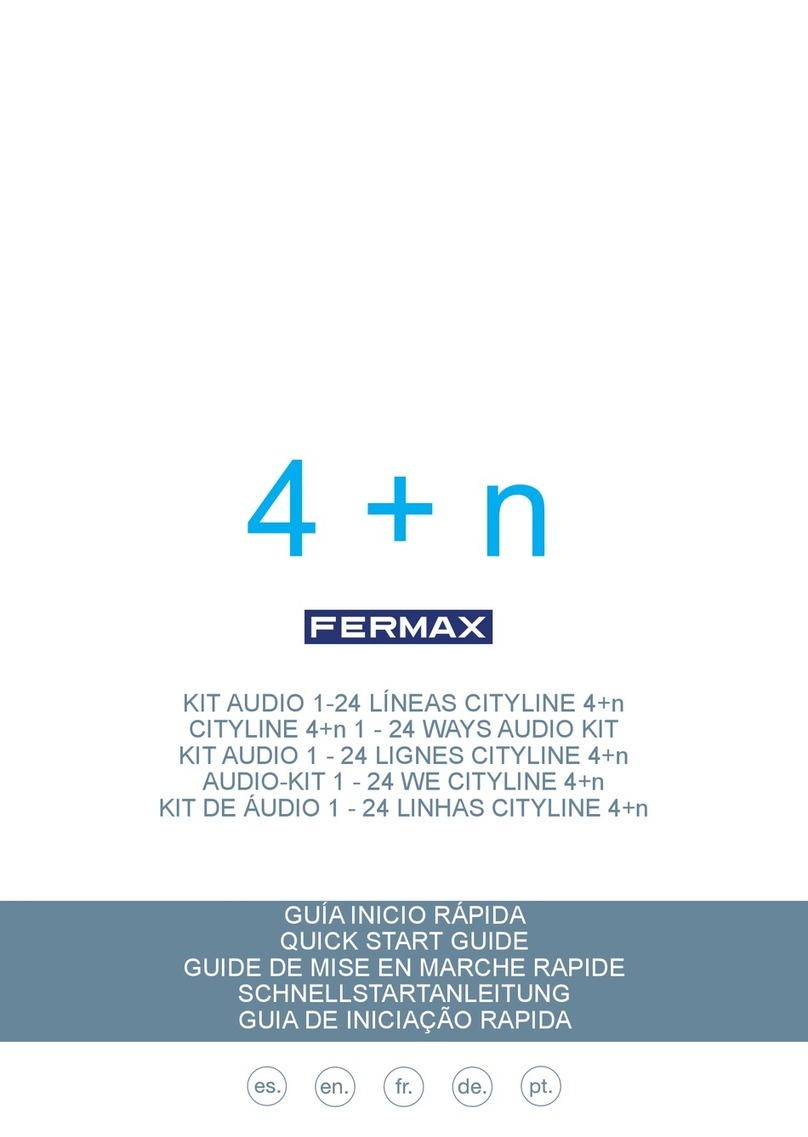RiTTO Twinbus 1 7630 Service manual

Issue 04.2007/lD No. 400 232 681-GB
RITTO TWINBUS
einfach planen sicher installieren.
®
QUICK REFERENCE
MANUAL
Door Intercom
and Video Systems
with TwinBus
Power Supply Unit
17573/01
General Information
Installation
Assembly
Starting Up
DoorStation/PowerSupply
Units
Service

Contents
2
Contents
Before continuing… 3
Using this document. . . . . . . . . . . . . . . . . . . . . . . . . . . . . . . . . . . . . . . . .3
Explanation of symbols used . . . . . . . . . . . . . . . . . . . . . . . . . . . . . . . . . .3
List of abbreviations . . . . . . . . . . . . . . . . . . . . . . . . . . . . . . . . . . . . . . . . .4
Terminal designations . . . . . . . . . . . . . . . . . . . . . . . . . . . . . . . . . . . . . . .4
Information on article numbers. . . . . . . . . . . . . . . . . . . . . . . . . . . . . . . . .4
General information 4
Cable network. . . . . . . . . . . . . . . . . . . . . . . . . . . . . . . . . . . . . . . . . . . . . .4
Cable layout . . . . . . . . . . . . . . . . . . . . . . . . . . . . . . . . . . . . . . . . . . . . . . .4
Maximum line lengths. . . . . . . . . . . . . . . . . . . . . . . . . . . . . . . . . . . . . . . .5
Considerations when renovating . . . . . . . . . . . . . . . . . . . . . . . . . . . . . . .5
Connection to the mains. . . . . . . . . . . . . . . . . . . . . . . . . . . . . . . . . . . . . .5
Intended use. . . . . . . . . . . . . . . . . . . . . . . . . . . . . . . . . . . . . . . . . . . . . . .5
Video camera installation location . . . . . . . . . . . . . . . . . . . . . . . . . . . . . .6
Cleaning . . . . . . . . . . . . . . . . . . . . . . . . . . . . . . . . . . . . . . . . . . . . . . . . . .6
Directives/conformity . . . . . . . . . . . . . . . . . . . . . . . . . . . . . . . . . . . . . . . .6
Warranty. . . . . . . . . . . . . . . . . . . . . . . . . . . . . . . . . . . . . . . . . . . . . . . . . .6
System bus. . . . . . . . . . . . . . . . . . . . . . . . . . . . . . . . . . . . . . . . . . . . . . . .6
Assembly 7
Power supply unit and additional devices. . . . . . . . . . . . . . . . . . . . . . . . .7
TwinBus indoor telephone 1 7630, 1 7650. . . . . . . . . . . . . . . . . . . . . . . .8
TwinBus indoor video stations 1 7855, 1 7857. . . . . . . . . . . . . . . . . . . . .9
Installation 10
Door intercom for single or multi-family residence . . . . . . . . . . . . . . . . .10
Video door intercom for single or multi-family residence . . . . . . . . . . . .11
Starting up 14
Door station/power supply units 16
Bus connector in the door station. . . . . . . . . . . . . . . . . . . . . . . . . . . . . .16
Portier door station. . . . . . . . . . . . . . . . . . . . . . . . . . . . . . . . . . . . . . . . .16
TwinBus built-in loudspeaker 1 4921 . . . . . . . . . . . . . . . . . . . . . . . . . . .17
TwinBus extension unit 1 4923. . . . . . . . . . . . . . . . . . . . . . . . . . . . . . . .18
TwinBus power supply unit 1 7573. . . . . . . . . . . . . . . . . . . . . . . . . . . . .19
TwinBus door selector switch 1 4982. . . . . . . . . . . . . . . . . . . . . . . . . . .20
Power supply unit video 1 4874 . . . . . . . . . . . . . . . . . . . . . . . . . . . . . . .22
TwinBus video line distributor 1 4813. . . . . . . . . . . . . . . . . . . . . . . . . . .22
Service 23
Measuring points . . . . . . . . . . . . . . . . . . . . . . . . . . . . . . . . . . . . . . . . . .23
Service indicators. . . . . . . . . . . . . . . . . . . . . . . . . . . . . . . . . . . . . . . . . .24

Contents
Before continuing ...
3
Before continuing ...
Using this document
This quick reference manual provides all the information required for installing, assembling, and starting up a TwinBus
for intercom system. It does not replace the system manual. It provides a basic overview for the most frequent use of
door intercom and video systems in single or multi-family residential buildings. Only those devices specified in the
Contents are described. The system manual can be ordered free of charge via the Internet at www.ritto.de or from
+49 (0) 02773/812-0.
Please keep this Quick Reference Manual on hand for later use.
Explanation of symbols used
Indication of risks:
Important information:
Circuit diagram symbols
Danger!
Type and source of the danger
This danger symbol indicates the risk of personal injury.
Caution!
Type and source of the danger
This symbol indicates the risk of equipment, environment or other property damage.
Note:
This symbol does not represent a safety note. It identifies information to better understand the
respective processes.
This symbol indicates an acoustic signal issued by a device should be observed. The length of the signal
indicates the acknowledgement of settings.
This circuit diagram symbol indicates a twisted pair of wires.
This circuit diagram symbol indicates that the line screening sheaths must be connected across the joints.

General Information
General Information
4
List of abbreviations
ED Apartment button
TÖ Door opener
UV Subdistribution
Terminal designations
a Bus terminal
b Bus terminal
ED Apartment button
ED Apartment button
a1 Main bus line
a2 Main bus line
a3 Main bus line
Va Bus terminal, video bus
Vb Bus terminal, video bus
Information on article numbers
The article numbers of RITTO products are made up of three components. For example 1 7630/70
1 7630 / . . Device: TwinBus indoor telephone
/7 . Colour: white
/ . 0 Device index
This document only specifies information on the respective device. Please refer to the RITTO Manual for the colours
available and current device versions.
General Information
Cable networks
Existing lines can be used as bus lines. We recommend the following, commercially available telecommunication lines:
Telecommunication line J-Y (St) Y
Telecommunication line J-2Y (z) Y with strain-relief
Telecommunication grounding cable, longitudinally and transversally waterproof
Cable layout
It is recommended to lay the bus line from subscriber to subscriber and to connect it to the connection terminal on the
device.
All the line screening sheaths must be connected across the joints and laid to Terminal b on the TwinBus power sup-
ply unit. Please use appropriate locally provided terminals for this.
The stranded video line Va/Vb can generally be laid in the cable with the screened a/b lines.
In order to fulfil the general safety requirements for telecommunication systems complying to VDE 0800 and prevent
disturbances on the lines, ensure that the mains voltage and SELV (TwinBus line) are laid separately. A clearance of
10 cm must be maintained for the installation. In the case of a common line cabling, a separating webbing must be
inserted in the installation channels.
Bus lines a/b must not be terminated with terminal resistors.
Caution!
Malfunctions due to strong magnetic fields
No other devices with strong magnetic field (contactors, transformers, etc.) may be installed in the
direct vicinity of the power supply unit and additional devices. Malfunctions could be caused by
induced voltage peaks.

General Information
General Information
5
Maximum line lengths
The loop resistance of each TwinBus line must not exceed max. 20 Ohm. This results in the following maximum line
lengths:
Considerations when renovating
If commercially available doorbells are used, they must not have a contact transition resistance in excess of 10 Ohm.
Connection to the mains
Please note that a 230 V/AC power supply is required for the power supply units and mains transformers which are
not explicitly depicted in the block diagrams.
Electrostatic charging
Intended use
The RITTO door intercom is a system devised for controlling access and internal communication inside residential
buildings.
Any other use is considered unintended use. The manufacturer is not deemed liable for any damage resulting from
unintended use. The risk, in this case, is assumed solely by the installation technician.
Intended use also includes observing the manufacturer's regulations concerning use and maintenance. The system
may only be installed and serviced by persons familiar with it and informed of the risks involved.
Wire diameter in mm 0,8 0,6
Resistance in Ohm/m 0,0349 0,0621
Line lengths between TwinBus power supply unit 1 7573 and indoor telephone or
indoor video station 280m 160m
Line lengths between TwinBus power supply unit 1 7573 and door unit (lighting) 60 m 30 m
Line lengths between TwinBus power supply unit 1 7573 and door openers up to
8V/1A 50 m 30 m
Line lengths between power supply unit 1 4874 and indoor video station 100 m 60 m
Line lengths between mains transformer 1 6477 and indoor video station 50 m 35 m
Line lengths between mains transformer 1 6477 and camera module 35 m 25 m
Note:
In the case of existing YR cables, all the free wires on the TwinBus power supply unit must be laid
as screening to a Terminal b.
Caution!
Equipment damage through overvoltage or short circuiting
Equipment damage can occur through overvoltage or short circuiting. Connection must be made to
a 230 V~±10% mains power outlet. The power must be fed via an intrinsic line safety switch with
max.10 A.
Caution!
Risk of equipment damage through static electricity (ESD)
Static electricity could destroy equipment if direct contact is made with the printed circuit boards.
Discharge electrostatic charges before touching the equipment.

General Information
General Information
6
Video camera installation location
A camera can only view a certain area. In order for the visitor who has just rung to be monitored, for example, the
camera must be appropriately installed.
The surveillance area varies according to the angle the camera module is set.
The installation height is approx. 1.5 to 1.6 m.
Cleaning
The surfaces of the TwinBus devices can become dirty due to environmental influences and frequent use. The sur-
faces should only be cleaned with a damp cloth and suitable, mild household cleaning agent.
Stainless steel surfaces should be cleaned regularly with a commercially available stainless steel cleaning agent.
Make certain that the plastic parts of the door station (e.g. name labels) do not come into contact with the cleaner.
Observe the information provided by the cleaning agent manufacturer.
Directives/conformity
All RITTO TwinBus devices have been constructed according to the following directives:
EC Directive "Electromagnetic Compatibility" 89/336/EEC or 2004/108/EC
(complying with the currently valid version).
Directives on low-voltage 72/23/EEC (complying to the currently valid version).
RITTO TwinBus devices bear the CE approval label. Conformity has been certified. The corresponding documents
are held by the manufacturer.
Warranty
The general terms of business implemented by RITTO GmbH & Co. KG apply.
System bus
The power supply unit and additional devices are connected via the system bus. The system bus connector, enclosed
with each additional device, is used for this purpose.
The additional devices receive their power supply via the system bus. If the devices are installed on several mounting
rails, the 1 6907 bus connector is used instead of the system bus connector. Connection is made from the right-hand
system bus connection of the device to the left-hand system bus connection of the following device.
Note:
The area surveilled must be well illuminated, also at night. If necessary, appropriate lighting must
also be installed.
We recommend positioning an external light about 1 m above the camera. It should be an incan-
descent bulb of at least 40 W.
The camera must not be pointed towards the source of light (sun, lighting, reflection, etc.).
Caution!
Risk to life from electric shock.
In the case of surface installation of the power supply unit, the terminal cover must be attached on
the 230 V connection.
Caution!
Damage to the device through environmental influences.
The devices must not be mounted outside or in rooms exposed to damp.

Assembly
Assembly
7
Assembly
Power supply unit and additional devices
4
5
3
2
100822-0
1
1
4
3
211 21a1 b
a2 ba3
b
N
L
1
2
00903-0
2
1
2
3
4
00904-0
3
1*
00538-0
4

Assembly
Assembly
8
TwinBus indoor telephone 1 7630, 1 7650
The following section describes the assembly of the TwinBus indoortelephone 1 7630. The assembly of the TwinBus
comfort indoor telephone 1 7650 is performed identically.
Connection
A Wall mounting
B Switch box mounting
A Standard connection
B Doorbell connecting option using 3
wires
Note:
Button adapter 1 4645 must be used when
multiple indoor telephones operated in paral-
lel are to react to one apartment button (ED).
Assembly
➤Please provide your customers with a copy of the
operating instructions for the TwinBus device. The
operating instructions are printed on the packaging
or are enclosed with the unit.
Surface-mounted
➤Please remove the clamp from the packaging.
EDEDba
ED
EDEDba
ED
AA BB
S0005-1
1
2
3
2
00001-0
1
120 mm
11 mm
00002-0
2
3
AA BB
4 x
2 x
00003-0
5
4
3
2
1
00004-0
4

Assembly
Assembly
9
TwinBus indoor video stations 1 7855, 1 7857
Surface-mounted
➤Remove the TwinBus device and the supplied com-
ponents from the packaging.
➤Please provide your customers with a copy of the
operating instructions for the TwinBus device. The
operating instructions are enclosed with the device.
➤Please remove the clamps from the packaging.
1
2
3
1
2
00811-0
1
120 mm
8,5 mm
2
AA BB
4 x
2 x
00813-0
3
00814-0
4
5
4
3
1
2
00815-0
5

Installation
Installation
10
Installation
Door intercom for single or multi-family residence
Each residential unit can be accessed separately from the main entrance. Thedoorbell for the apartment door is con-
nected directly to the indoor telephone. Incoming calls from the door station and the apartment door (ED) are auto-
matically indicated by different ringing tones. The door opener (TO) at the main entrance can be actuated from all the
indoor telephones.
Block diagram: Door intercom for single or multi-family residence.
* Please note the red mark – see “Bus connections in the door station” on page ☞16.
Circuit diagram: Door intercom for single or multi-family residence.
B0089-3
4
1 7573
2
RiTTO
a3
2
a2
22
2
2
22
a1
RiTTO
1 4760
1 4753
1 4753
2
ED
2
1 7630 ED
2
1 7630 ED
230 V
1 7650
1 7230
2
ED
S0089-3
11 21 a3 bNL
4321
1234
a3
a2
a1
EDEDba
ED
EDEDba
ED
EDEDba
ED
EDEDba
ED
a2 ba1 b 1 7573
1 4760 RiTTO
1 4753
1 4753
1 7650
1 7630
1 7630 1 7230

Installation
Installation
11
Video-door intercom for single or multi-family residence with one main bus line with
handsfree video intercom unit 1 7835, 1 7845, or indoor video station 1 7855, 1 7857 with
decentral power supply
Block diagram: Video-door intercom for single or multi-family residence.
* Please note the red mark – see “Bus connections in the door station” on page ☞16.
Circuit diagram: Video-door intercom for single or multi-family residence.
Note:
The block diagram and circuit diagram apply similarly for indoor video station 1 7855 and handsfree
video stations 1 7835, 1 7845.
1 6477 2
8
2x2
2x2
2x2 1 7573
2
1 6477
UV
2ED
1 7857
1 6477 22ED
1 7857
1 6477 22ED
1 7857
B0112-0
RiTTO
1 4783
1 4753
1 4760
S0117-2
1 6477
1 6477
1 6477
1 7573
1 4760
RiTTO
1 4783
1 4753
1 7857
1 7857
11
NL
432
2
1
1
34 a121 b b ba2 a3
NL 2 31
2VaVb1
NL123
abVbVa 5251
VbVa 5251
ED
ED
123
ED
NL
abED
ED
ED
a1

Installation
Installation
12
Video door intercom for single or multi-family residence with 3 main bus lines and indoor
video stations 1 7855, 1 7857, or handsfree video station 1 7835, 1 7845 with central power
supply and line distributor 1 4813
Block diagram: Video door intercom for single or multi-family residence with 3 main bus lines, central power supply and line
distributor.
Note:
The block diagram and circuit diagram apply similarly for indoor video station 1 7855 and handsfree
video station 1 7835, 1 7845.
Note:
Manual picture activation is not possible with this circuit configuration.
Parallel operation is not possible with this circuit configuration.
B0111-0
a3
2x2+2
2x2+2
2x2+2
a2
2x2+22x2+22x2+2
2x2+22x2+22x2+2
2x2+22x2+2
a1 max. 12max. 12max. 12
2
ED
2
ED
2
ED
2
ED
2
ED
2
ED
1 4783
1 4753
1 4753
1 4760
RiTTO
8
2
1 75731 4874 1 4874 1 4813
1 6477 1 4874
UV
1 7857 1 7857 1 7857
1 7857 1 7857 1 7857

Installation
Installation
13
* Please note the red mark – see “Bus connections in the door station” on page ☞16.
**Please note the system bus connection – see “System bus” on page ☞6.
***Max. 12 indoor video stations (without manual switch-on rights and without parallel operation) per power supply unit 1 4874.
Circuit diagram: Video door intercom for single or multi-family residence with 3 main bus lines with indoor video unit 1 7855,
1 7857 or handsfree video intercom unit 1 7835 and 1 7845 with central power supply and line distributor 1 4813.
S0118-1
abVa Vb 51 52
ED
ED
11 21 a1 bNL
432
2
1
134
VbVa VbVa VbVaE++VbVa
NL 2 31
ED
a1
abED
ED
ED
abVbVa 5251
VbVa 5251
ED
ED
ED
abED
ED
ED
NL +
1 2VbVa
NL +
NL +
max. 12 max. 12 max. 12
a3
51 52Va Vb
a2 b a3 b
a2
1 4760
1 4783
1 7573
1 6477
1 4874
1 4753
RiTTO
1 4813
1 7857
1 7857
1 7857

Starting up
Starting up
14
Starting up
The system can be started using the indoor telephone, indoor video unit or apartment doorbell button. Start-up using
the apartment button is useful if you do not have access to the residential unit.
In order to allow the operator to change the call tone of the main bell button, the main bell buttonmust be programmed
as the main button when initial setting takes place. The procedure must be repeated for other bell buttons.
The intercom can be used for start-up with two persons.
An internal call number must be assigned to each indoor telephone for internal communication. When the internal call
number is programmed, the indoor telephone is known to all subscribers connectedto the bus line. For example, sub-
scriber 1 is selected by all other subscribers using the button that has been assigned to subscriber 1 as the internal
call number. Please print the labelling field of all the indoor telephones accordingly.
Start-up using indoor telephone/video unit
Please observe the enclosed product description for start-up of compact intercom unit 1 7132 or handsfree intercom
unit 1 7230.
One-man start-up
Two-man start-up
Operation Device
1. Switch on Customer line safety switch
2. Deactivate1) adjustment protection
1) Deactivated at factory - refer to Page ☞20.
TwinBus power supply unit 1 7573
3. Programming the main doorbell Assign door station and intercoms
4. Program2) internal call numbers
2) Optional for 1 7650, 1 7835, 1 7845, 1 7855.
Intercom units with internal communication
5. Adjust door opening time TwinBus power supply unit 1 7573
6. Activate adjustment protection if required TwinBus power supply unit 1 7573
Activity Result
Activity Result
Press and
hold 5 sec Flashes
Within one minute
press the button to be as-
signed on the door station
Acoustic signal for con-
firmation
RiTTO
Press and
hold 5 sec Flashes
RiTTOButton to be assigned
Announce via voice con-
nection
Within
one minute,
press the button
tobeassignedon
the door station
RiTTOAcoustic signal for
confirmation
RiTTO

Starting up
Starting up
15
Start-up using the apartment button
If the time limit has been exceeded:
➤Repeat the procedure.
If the programming procedure failed:
➤Check on the TwinBus power supply unit whether the setting protection is activated - see page ☞20.
➤If 10 bell buttons have already been programmed, the telephone or indoor video unit memory is full. If necessary,
delete all the settings and reprogram the bell button that is needed (only possible if you have access to the
apartment).
Delete settings
This function deletes all settings and programmed bell buttons. If necessary, please note any existing customer set-
tings before deletion.
Adjustment protection
The TwinBus power supply unit enables the indoor telephone/video unit connected to be provided with an adjustment
protection to prevent them being adjusted without authorisation - see page ☞20.
Activity Result
✔Short tone: Device is ready for operation.
/No tone: Time limit exceeded.
/Long tone: Programming procedure has failed.
Activity Result
✔Short tone: Settings have been deleted.
/Long tone: Settings have not been deleted.
Pressandhold"P"
until
LD 1
Flashes
yellow
LD 2
Flashes red,
LD1
goes out
Within
threeminutes, go to
the apartment but-
ton. Press and hold
it for 5 sec
Acoustic sig-
nal for
confirmation
Withi
n one m
i
nu
t
e,
press the button to be
assigned on the door
station
RiTTOAcoustic signal for con-
firmation
RiTTO
Press and
hold 5 sec
+Acoustic signal for con-
firmation

Door station/power supply units
Door station/power supply units
16
Door station/power supply units
Bus connector in the door station
The door station modules are connected to the bus connectors one under the other.
The wires in the door station bus connector marked red must be attached to the pin labelled "red" on the board. As a
result, the door station modules are numbered identically. The wire marked red is identified in the respective circuit
diagram by a "*".
Portier door unit
Frame installation
Module assembly
Connection
* Please note the red mark – see “Bus connections in the door station” on page ☞16.
Circuit diagram: Connection of the door unit
1
4 x
3
4
4 x
5
4 x
6
3
2
00346-1
1
TOP
Oben
2
1
1
2
3
00347-1
1
1
2
00351-1
2
11 21 b b ba1 a2 a3NL
1
234
1234
1 7573
1 4760
RiTTO
1 4752
S0051-2

Door station/power supply units
Door station/power supply units
17
TwinBus built-in loudspeaker 1 4921
Device description
Built-in loudspeaker 1 4921 is integrated in an existing bell or letter box system in order to convert it into a TwinBus
door station.
Starting up
Connection
* Please note the red mark – see “Bus connections in the door station” on page ☞16.
** Wires 3 and 4 of the door station must be connected.
Circuit diagram: Connection of the built-in loudspeaker
Note:
Use an additional mains transformer 1 6476 if you are operating the modular Portier door station with
more than 6 illuminated modules.
Operating elements
1. Door-to-apartment volume setting
2. Apartment-to-door volume setting
3. Bell button connection
4. Door bus connection/4-wire
Function Activity Result
2
1
3 4
00275-0
rot
rot
Adjusting the lis-
tening volume Adjusting the
potentiometer
Adjusting the in-
tercom volume Adjusting the
potentiometer
S0040-2
11 21 a1 a3 b
bba2NL
4321 K2 K3 K4 K5 K6 K7 K8 K9K1K 11 1210
1234
1 4921
KL1
KL2
KL3
KL4
KL5
KL12
1 7573

Door station/power supply units
Door station/power supply units
18
TwinBus extension unit 1 4923
Expansion unit 1 4923 is used to expand built-in loudspeaker 1 4921. It allows an additional 12 bell buttons to be
connected.
* Please note the red mark – see “Bus connections in the door station” on page ☞16.
* Please note the red mark – see “Bus connections in the door station” on page ☞16.
Circuit diagram: Connection of the expansion unit
Note:
Customer-installed illumination up to max. 11 V / 1.6 A can be connected to terminals 3 and 4 on
power supply unit 1 7573. If long lines are used or the connections are not suitable, care must be
taken to ensure the voltage on built-in loudspeaker 1 4921 on terminals 3 and 4 is not less than 10 V.
43
5
1
2
00279-0
1
K
K1
K2
K3
K4
K5
K6
K7
K8
K9
10
11
12
4
3
2
1
00213-0
2
S0045-2
1 4921
4321 K2 K3 K4 K5 K6 K7 K8 K9K1K 11 1210
KL1
KL2
KL3
KL4
KL5
KL12
K2 K3 K4 K5 K6 K7 K8 K9K1K 11 1210
KL13
KL14
KL15
KL16
KL17
KL24
1 4923

Door station/power supply units
Door station/power supply units
19
TwinBus power supply unit 1 7573
Device description
The power supply provides the power for the devices attached to the TwinBus. It controls the door station and provi-
des functions that the connected subscribers can use.
Setting commands
The power supply unit 7573 provides the option of programming 4 switching commands (e.g. from button adapter
1 4645, coding module 1 4764, access module 1 4768, etc.) to operate the door opener.
The procedure is described here in an example of entering a numeric code via the coding module.
The entry must be terminated with "E".
Adjust door opening time
The door opening time can be set within a range of 1 to 120 seconds. The factory setting of the running time is 3
seconds.
* 1 x flashing = 1 sec.
Further information on the power supply unit is available in the Chapter "Service" - refer to Page ☞23.
Connections
L, N 230 V mains connection
1, 2, 3, 4 Door station, polarized
3, 21 Door opener
11 Control line for door opening relay
a1, b Main bus line 1
a2, b Main bus line 2
a3, b Main bus line 3
System bus for supplying additional devices
Activity Result
Activity Result
Press and hold
"P" until LD 1
Flashes yellow
C0E
789
456
123 Enter numeric
code, e.g.
012345E
RiTTOacoustic signal
for confirmation
Press "P"
again LD 1 (yellow)
goes out
Press and hold
"Z" *
LD 1
Flashes yellow

Door station/power supply units
Door station/power supply units
20
Delete settings
Activating/deactivating adjustment protection
TwinBus door selector switch 1 4982
Device description
A door station is added to a system using door selector switch 1 4982. An additional door selector switch is needed
for every 2 additional door stations. A maximum of 8 main door stations can be connected.
The loudspeaker, the door opener and the camera signal are switched through from the door station to the intercom
units. The device is operated as an additional device with a TwinBus power supply unit 1 7573.
Connection
Block diagram: Door selector switch 1 4982
Activity Result
Activity Result
Note:
Adjustment protection remains in effect after activation on the TwinBus power supply unit
1 7573 in indoor telephones and indoor video stations even if electrical power is turned off
to the indoor telephone or indoor video station.
2
1
Press "P"
and then "Z" until LD 1 is lit
yellow briefly
Press
Prog. prot. ON
until LD 3
is lit green
Press
Prog. prot. OFF
until LD 3 (green)
goes out
2
2
2
RiTTO
1 4760
1 4753
2
1 7630
ED
2
1 7630
ED
2
1 7630
ED
1 7573 1 4982
2
UV
2
44
RiTTO
1 4760
1 4753
B0098-0
This manual suits for next models
3
Table of contents
Other RiTTO Intercom System manuals
